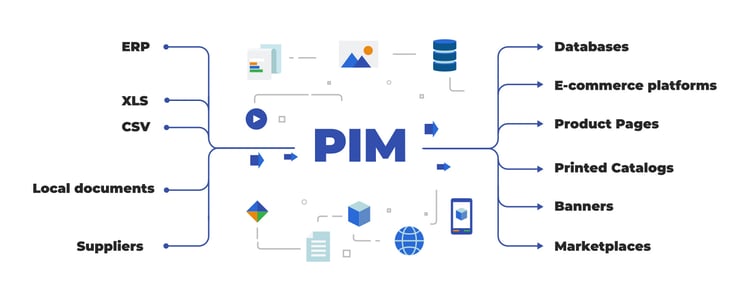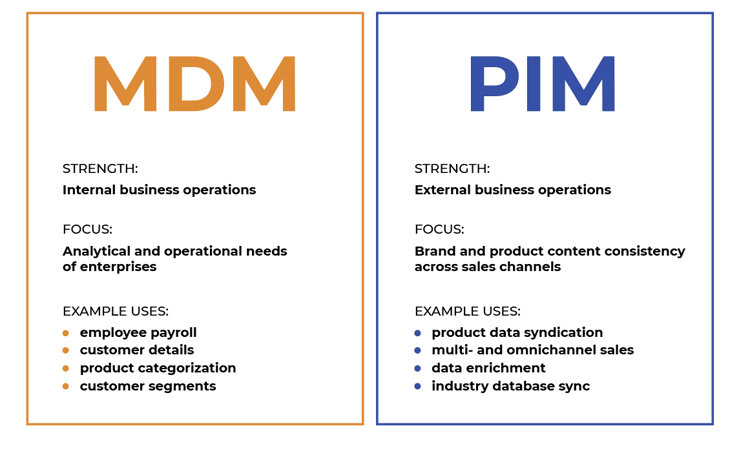PIM vs MDM: Functions, Benefits, and Differences

What are the differences between product information management (PIM) and master data management (MDM)?
For a start, both are data management strategies with the same goal: to break down data silos and create a centralized data source that can support business activities. However, they manage different types of data, and therefore their systems differ in their functions and capabilities.
This is what differentiates PIM from MDM. PIM cannot do what MDM can, and vice versa.
In this case, how can you determine which of these two systems is the right choice for your business?
Below, we explain in more detail what PIM and MDM are, what their respective strengths are, and how you can choose the most appropriate system for your business.
For a quick summary, check out the key takeaways in the following section, or watch the video below.
Key Takeaways
-
PIM and MDM are data management strategies. Both aim to create a single source of truth for data that is in a standardized format and accessible to all who need it.
-
PIM focuses on managing product information — descriptions, technical specifications, digital assets, and so on. MDM manages a broader range of core business data about products, customers, suppliers, finance, and others.
-
Unlike MDM, PIM does not manage critical enterprise-wide data. On the other hand, while MDM can manage product information to a certain extent, it lacks the content enrichment and data syndication capabilities that are core functions of a PIM system, among many others.
-
PIM is ideal for companies managing complex product catalogs, aiming to expand into new sales channels or markets, and seeking to implement or enhance an omnichannel strategy through centralized management and automated syndication of consistent content.
-
MDM is best suited for companies that need to manage diverse business data across multiple departments and sources to support strategic decision-making and compliance with data governance standards.
-
Using a robust PIM or MDM system makes data better, cleaner, and easier to access, and it provides clear ways for companies to use data properly.
- PIM has also been compared to other similar systems like Enterprise Resource Planning (ERP) and Content Management System (CMS).
What is Product Information Management (PIM)?
Product information management (PIM) is about organizing and enriching your product information and making it available on the channels through which you market or sell your products.
At the heart of any PIM strategy is the establishment of a single source of truth, a central "home" where all the information about your products is stored, such as product descriptions, digital assets, technical specifications, localized data and more.
Whether someone is uploading new products to your eCommerce store, preparing an ad, or designing a product catalog, your team can easily find the product information they need and be confident that it's error-free and ready for distribution.
Key Functions of PIM
If a company needs to manage lots of information about their products, a PIM system is the best tool for that job, with several special functions that can do the following:
-
Consolidate all product information in one place. With a single source of truth for all product data, managing, adding or updating data becomes a simple task — you only need to do it once, and it's synchronized across all systems, ready to be used by your team or partners.
-
Standardize product information. Different systems and teams may represent data in their own way, such as the date in a format other than day/month/year. This inconsistency leads to data quality issues that can derail your sales and marketing efforts. PIM solves this problem by ensuring that all data conforms to a set of predefined rules and validations, resulting in a consistent and clear format.
-
Enrich product content. Assign descriptions, images, videos, product relationships, variants, and even translations to products. PIM systems perform checks to ensure that no important attributes or data fields have been accidentally left blank. When all the important information is filled in, you maximize the chances that your products will stand out from those of your competitors.
-
Simplify and automate multichannel distribution. Most websites, eCommerce platforms, and sales tools require product data to be uploaded in a specific format, but manually preparing the data for each channel can be a tedious process. PIM connects to these channels via APIs so that data is automatically distributed with just a few clicks. All you need to do beforehand is upload the product data to PIM system once.
Early PIM systems were designed simply to collect and store a variety of product information and digital assets from other data sources. Today, however, PIM solutions can do so much more than just be a data repository; they can drive online sales.
 PIM stores data pulled from several other sources in a single system, which allows for an easy management and enrichment process, before distributing them to other channels.
PIM stores data pulled from several other sources in a single system, which allows for an easy management and enrichment process, before distributing them to other channels.
Not only can it store information such as a product's name, description, category and other attributes, but it also comes with market and language support, as well as digital asset management capabilities to store images, videos, and PDFs, and create product descriptions using AI.
The capabilities of PIM systems are constantly evolving and becoming more powerful.
Benefits of PIM
Now that we know what PIM can do with product information, let's focus on what PIM can do for your business. For companies with a well-implemented PIM system, they can expect several benefits, such as:
-
Better product data quality and consistency. Having all product information stored in a single system simplifies data management. This makes it easy to keep your data accurate, up-to-date, and consistent, making it easier for your team to work with dependable data.
-
Improved cross-functional collaboration. Marketing, sales, and external partners can find and share product information in one secure, centralized location. Customizable user controls grant access to the right level of editing or approval permissions, so you can avoid conflicting messages. That way, everyone on your team stays on the same page.
-
Speed up time-to-market with automation. When you import new product information into the PIM system, you do not have to manually type out each data field. Advanced mapping accurately reads incoming data files and validates the required fields, saving hours of data entry. Once all data is entered and refined, it can be automatically distributed to other channels via integrations and APIs.
-
Consistent branding and messaging. When all teams share the same authoritative product information through a central PIM system, there is no room for discrepancies in product content, images, messaging or other brand elements. All product information and digital assets adhere to the established format and style guide, and each piece of published product content perfectly represents the corporate identity.
-
Happier and more satisfied customers. A common complaint from online shoppers is that the product they receive does not match the information they read on the product page. The likely cause? The company accidentally forgot to update that sales channel when revising product information. PIM prevents overlooked channels from publishing obsolete or inaccurate product content, so you do not accidentally mislead customers.
-
Borderless growth. Taking a brand global demands localized content tailored to local conditions. PIM streamlines internationalization through automatic translation and regional filtering of customized product catalogs. With a single convenient system for customizing regional preferences, specifications, languages, and pricing, companies can remove obstacles to overseas momentum and reach new audiences with culturally relevant product content that appeals to their needs and preferences.
-
More sales by delivering an omnichannel customer experience. When companies publish consistent, timely product content across all touchpoints, shoppers feel empowered and engaged. Shoppers who enjoy a seamless shopping experience often become customers, which translates into higher online or in-store sales. Satisfaction spreads through word-of-mouth, which further increases sales success through organic reach.
What is Master Data Management (MDM)?
Master data management (MDM) is a data management approach that consolidates an organization's most important data domains into a single, authoritative source of truth. These critical data domains, known as master data, typically include entities such as customers, products, materials, employees, and vendors.
Master data (also referred to as the "golden record") is the foundation of any successful business. It provides a unified, accurate, and comprehensive view of critical business information, allowing companies to make informed decisions and achieve operational excellence.
But as companies grow and scale, the amount of data they collect and process increases exponentially. What's more, the data is needed by various teams and individuals across the enterprise who must rely on it to make data-driven decisions in their day-to-day operations.
To accomplish this, executives needed a suitable environment where everything there is to know about a product or other aspect of the business is available in the form of a reliable, authoritative reference point.
This is where master data management systems came in.
Key Functions of MDM
MDM is specifically designed to meet the analytical and operational needs of enterprises, and can perform the following:
-
Create an authoritative data source. By unifying, cleansing and standardizing master data that originates from other systems and channels, MDM can ensure that data is accurate, consistent and reliable. With everything in one place, data can be quickly enriched, updated, or shared with other systems.
-
Secure critical data in a single system. Store and manage all business-critical data in a centralized system where data governance policies can be set to control data access and usage, ensuring that only authorized personnel can access and modify the data.
-
Enforce data quality procedures. Implement standardization rules and naming conventions to ensure consistency and facilitate data integration and analysis. Ensuring that the data adheres to defined quality standards means your team can trust the data and use it to make critical business decisions with full confidence in its accuracy.
Benefits of MDM
By establishing a consolidated, trustworthy source of master data across an organization, companies can gain a number of competitive advantages. Some of the benefits include:
-
Improved data quality. Data profiling, data cleansing, and data standardization tools in MDM help eliminate redundancies, inconsistencies, and errors, and ensure that data is accurate, complete, and up-to-date.
-
Quick and easy access to clean data. Data can be organized and made easily accessible to authorized users, reducing the time and effort required to find and access information.
-
Time savings through automation. MDM can automate many data management tasks that would otherwise require significant manual effort. This frees up time for your team to focus on other important tasks.
-
Regulatory compliance. With the ability to set and enforce data quality standards to comply with regulations such as the General Data Protection Regulation (GDPR), companies can ensure the accuracy and completeness of data and track data lineage for audit purposes.
-
Enhanced collaboration between cross-functional teams. Facilitate collaboration between different teams and departments by providing a single view of data, enabling faster decision-making, and reducing the time and effort required to reconcile conflicting information from multiple sources.
How Can You Decide If You Need PIM or MDM?
Ultimately, the choice between PIM and MDM depends on a company's specific requirements.
PIM focuses entirely on product information and its effective management. It is an ideal solution for companies that have a large number of SKUs, need to adapt their product information to new sales channels or markets, or want to create a seamless omnichannel experience for their customers.
Compared to MDM, PIM is a cost-effective solution and offers more specialized tools and functionality to manage and optimize product data for marketing and sales purposes. However, it does not provide the same rich master data capabilities, governance, security and integration features that a dedicated MDM platform provides for the entire enterprise.
MDM, on the other hand, is suitable for companies that need to manage multiple data domains, such as customer, financial, product, or employee, and want to create an accurate, trusted view of all data that can be used across the enterprise to make business decisions.
Its focus is on internal business processes, improving and managing data integrity, and facilitating collaboration between cross-functional departments. While MDM can also handle product data, it does not provide the same level of detailed product information management and enrichment as PIM.
If the distinction between PIM and MDM still seems unclear to you, here are some common use cases for both solutions:
5 signs that show you need PIM
1. You manage a large number of SKUs and struggle to keep track of them all
If you run a small retail business with fewer than 100 SKUs, manually managing product information and the catalog can take some time, but otherwise it would not prove to be a huge challenge.
But what happens when you have over 1000 SKUs, like Walmart with over 400 million SKUs?
It's not uncommon for companies with a enormous catalog to lose track of some products or have difficulty keeping them accurate and up-to-date across all channels. Data chaos ensues and the quality of product content suffers, leading to negative customer experiences, product returns and poor reviews.
With PIM, companies can easily manage their entire product catalog, including description, attributes, and pricing, and automatically synchronize across all digital channels in real time.
2. You encounter data quality issues
Are you trying to eliminate error-prone habits in your organization, such as using spreadsheets to store your product data?
It is possible to manage several hundred items with a single spreadsheet. But even with a relatively small number of products, different teams working on the same data can unknowingly cause data quality issues, such as inconsistent product information, conflicting pricing, and obsolete product descriptions.
Manually updating product attributes or image metadata is a detailed task. To maintain product data quality and integrity, it is necessary to implement a PIM solution that can automate this process and save you hours or even days of work.
3. You want to open new sales channels, but you do not have enough manpower to do it
Opening up new sales channels often means you need more people on your team or spend more time managing them.
This obviously does not lead to the business growth you want, as it increases costs and potentially leads to chaotic organization within the company (this is entirely possible if product data is spread across spreadsheets and handled by multiple employees).
For retailers, moving to PIM not only automates data entry for every single SKU you have, but also streamlines product content management and distribution across all sales channels, allowing you to expand and reach more customers without driving up your overhead costs.
4. You struggle to start or maintain an omnichannel strategy
Are you experiencing high bounce rates in the early stages of your sales funnel? If so, it may be because customers are put off by the inconsistent information about the products in your omnichannel and are bouncing.
Given that customers want a personalized, seamless shopping experience, this does not come as a surprise.
Omnichannel is about improving the shopping experience and putting your customers at the center of your marketing strategy. Whether customers want to buy products in a brick-and-mortar store, via desktop, or on mobile devices, all processes should be fairly simple for them.
Even world-famous brands like Starbucks offer the ability to order online and pick up in-store — a feature that has become increasingly popular with customers over the years.
While MDM or enterprise resource planning (ERP) systems can help you solve internal operational challenges, the PIM solution is the right tool for an omnichannel strategy, as it can leverage your product information to maximize awareness of your products in the online space and help customers explore product options while using different sales channels.
Today's shoppers should be constantly reminded of the product on multiple platforms and have the option to buy on the platform of their choice and use the most convenient payment method.
5. You want to expand into international markets, but lack the tools that can support you
There are many attractive markets in the Asia-Pacific region (think China, which accounts for about 50% of global eCommerce sales).
To gain a foothold in international markets, you need to offer payments in multiple currencies and translations into multiple languages, as well as explore local marketplaces.
You can do all this with a flexible PIM solution that comes with features and integrations to enhance your sales and marketing activities, such as:
-
Automatic translation of product information into multiple languages to engage customers in their local language.
-
Channel-specific filtering to tailor product content to the specific requirements of each sales channel or region.
-
Easy integration with online marketplaces and eCommerce platforms.
To learn more about the business value of PIM software, get our free eBook 5 Sure Signs You Need a PIM System.
5 signs that show you need MDM
1. Master data is stored in an inconsistent format
When there is no MDM system in place, different teams within an organization capture data in different ways, making it difficult to find specific records in the database.
One team stores customer names in "Last Name, First Name" format, while another team stores them in the opposite order: "First Name, Last Name". This inconsistency can lead to confusion and errors when you search for customer records or try to merge duplicate records.
This problem can be solved with an MDM system that ensures all data is consistent across multiple platforms within an organization. This saves time for employees who would otherwise have to manually reconcile discrepancies.
2. New integrations are implemented
Implementing integrations with other companies is time-consuming and technically challenging.
To avoid delays in data integration, the company should take advantage of an MDM system that enables integration and analysis of data from multiple companies.
When using MDM, data integration does not require increasing the headcount, as a data management platform can help automate processes and meet operational and analytical needs.
3. Data governance initiative fails
Data governance protects data while making it accessible to the right teams. Failure to do so can result in hefty fines. For example, the GDPR (General Data Protection Regulation) can impose a fine of up to 2% of a company's global revenue.
Companies can benefit from using master data management software that doesvetails with enterprise master data governance systems and programs. With an MDM solution, teams get the right framework for protecting data and its accuracy.
4. There is no overview of the supply chain
Supply chain management also requires the right software.
MDM can be used to sort and validate data and create a complete overview of all suppliers. Transparency and consistency of supply chain data across the enterprise can help provide useful insights needed to improve business models.
In addition, using an MDM solution to capture supplier data is a secure option, as it enables the creation of backup copies of data and the recovery of lost data.
5. Customer data is scattered across multiple systems
There is a huge amount of customer data to capture, manage and analyze.
Without a centralized system to manage this data, companies often struggle to keep track of their customers' information, such as contact details, purchase history and preferences. This can lead to customer frustration and missed opportunities for upselling or cross-selling.
For example, a customer may have updated contact information or product interests. However, because the data is stored in separate, non-integrated systems, the marketing manager may not have access to the right data, which can result in marketing messages that are irrelevant or inappropriate for the customer.
With an MDM, the company can consolidate all information from disparate systems, create a single source of truth for customer data, and help its teams deliver a personalized and seamless experience for their customers.
PIM vs MDM in a Nutshell
While PIM and MDM share the common goal of creating a centralized and trusted data source, the main difference between them is that MDM primarily supports internal business processes and facilitates collaboration between cross-functional departments, while the PIM system supports external business processes and creates omnichannel consistency.

In this respect, MDM and PIM complement rather than undermine or exclude each other.
For some large enterprises, both PIM and MDM solutions can be useful because they are not mutually exclusive, only complementary. The PIM system can help organize enterprise-wide data, avoid data inconsistencies, and most importantly, build an effective omnichannel strategy for marketing purposes.
By using both systems, companies can create a comprehensive data management strategy that covers all aspects of their business, from organizing company-wide data to supporting an omnichannel customer and retail strategy.

Effective product information management is the linchpin of any retail or eCommerce business. Clean, accurate, and enriched product content is what keeps customers engaged and delivers a seamless and personalized shopping experience.
Bluestone PIM provides a comprehensive solution for managing and enriching vast amounts of product information, facilitating seamless omnichannel experiences, and adapting to new sales channels and markets. Get in touch with our PIM advisors today to schedule a free consultation or book a product demo to see how Bluestone PIM works behind the scene.
Editor’s note: This post was originally published in June 2022 and has been updated with the latest information.




